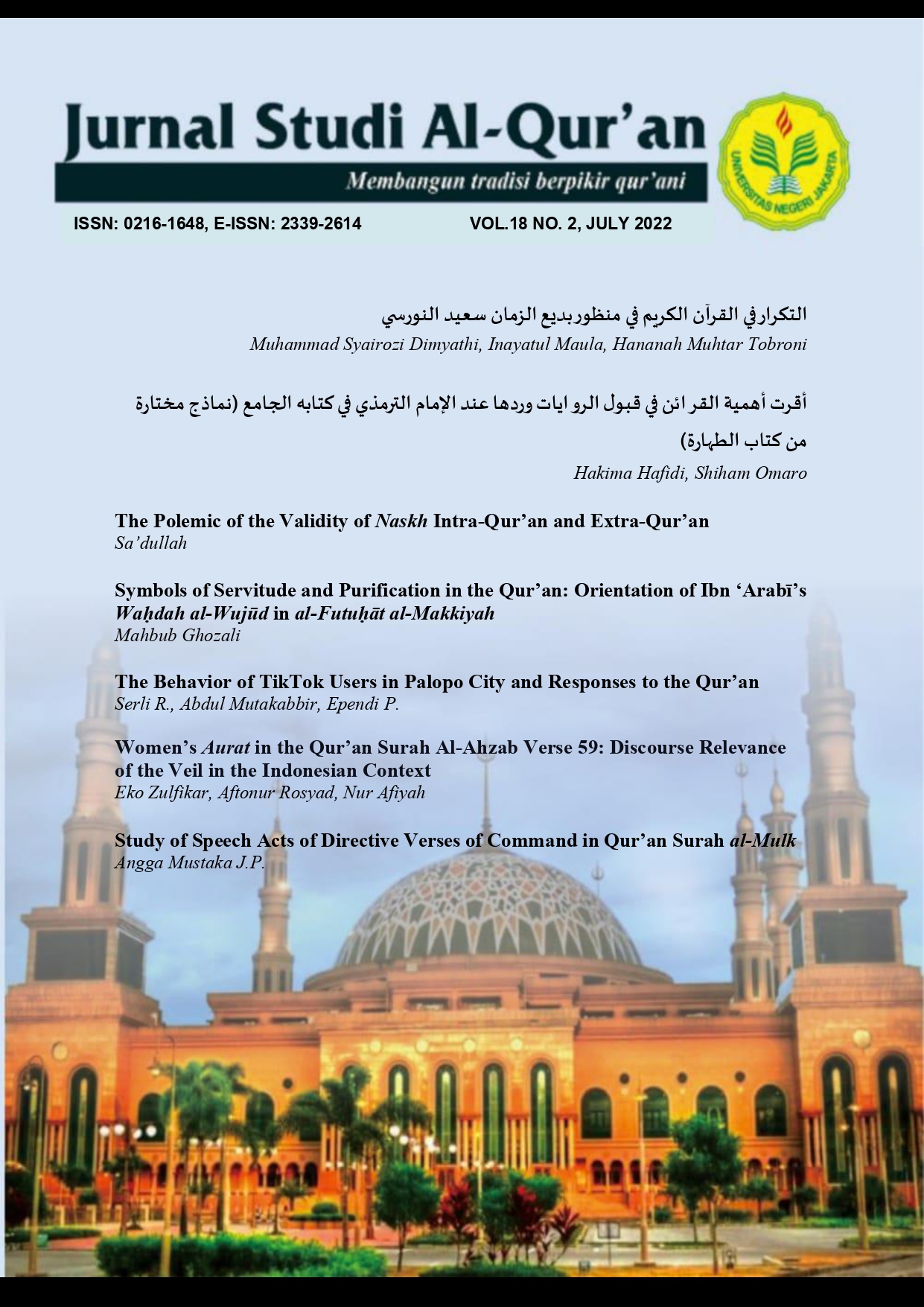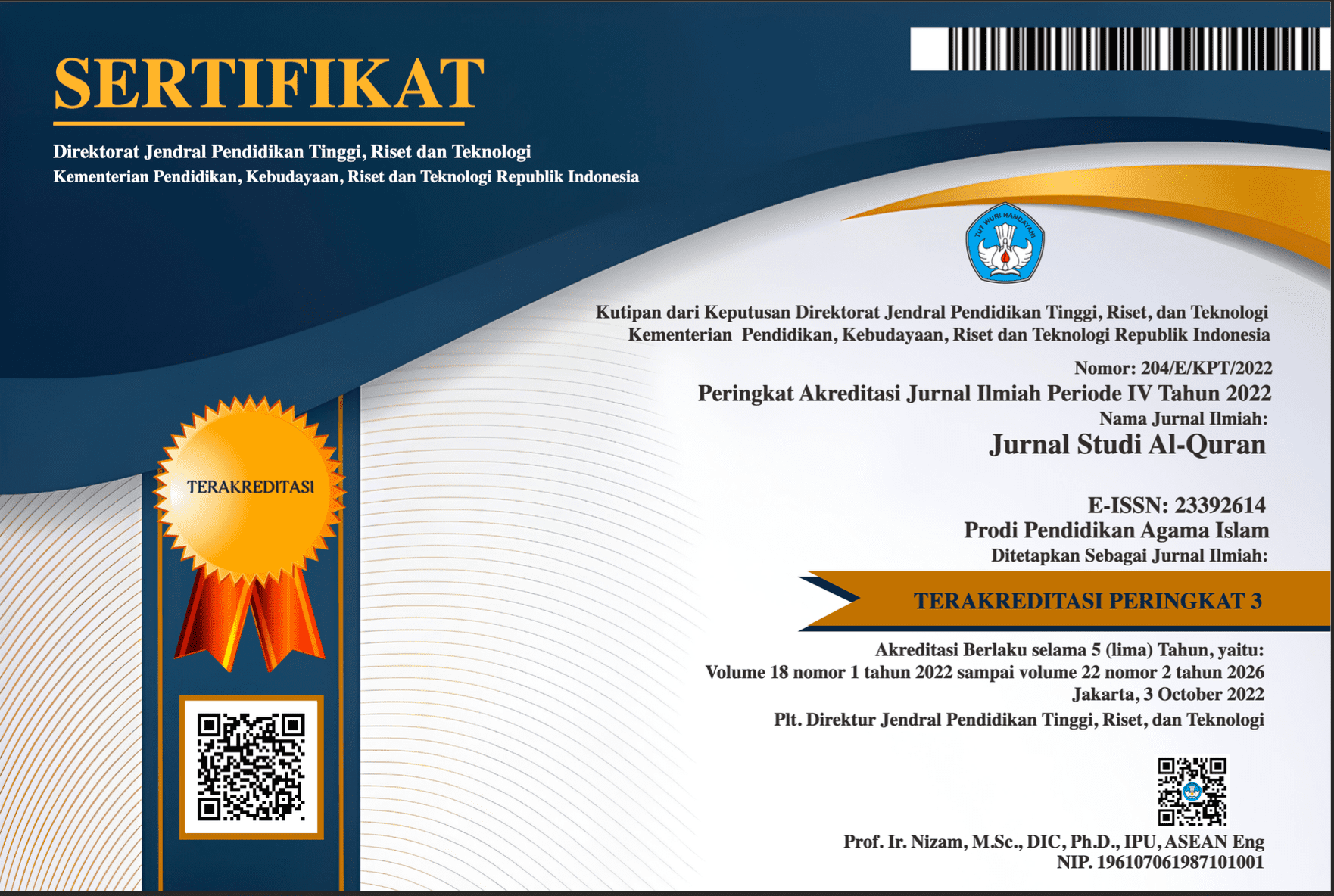Symbols of Servitude and Purification in the Qur’an: Orientation of Ibn ‘Arabī’s Waḥdah al-Wujūd in al-Futuḥāt al-Makkiyah
DOI:
https://doi.org/10.21009/JSQ.018.2.04Keywords:
Ibn 'Arabi, Semiotika, TafsirAbstract
The complexity of the concept waḥdah al-wujūd in Ibn ‘Arabī understanding used in interpretation impacts the ignoring of his interpretation results leading to the essence of servitude and purification of God. The purpose of this study is the form of understanding that accentuates the meaning of the symbols depicted in verse. Tracing of Sufistic narratives in interpreting Ibn ‘Arabi was carried out in this study using qualitative methods with content analysis as a data analysis technique. The content analysis model analyzes the data by looking for conceptual relations in al-Futuḥāt al-Makkiyah by Ibn ‘Arabi about the Sufistic model of understanding. The semiotic theory of sacred texts aids this analysis process to see language phenomena in the scriptures presented through special symbols. This study found that the Sufistic interpretation of Ibn ‘Arabi is wrapped in symbolic form. The dressing of symbols in the process of understanding emphasizes the identification of Sufistic models with the diversion of meanings. This identity obscures Ibn ‘Arabī’s method of interpretation. The symbolic form is explained by analysis of the constitutional significance of the word writing and the function of his syntagmatic. The implications of this concept emphasize the relationship between God and servant (‘abd) implicit in each verse of the Qur’an. The result of the manifested interpretation underlines the totality of servitude and divinity, culminating in the level of the union of existence to God (waḥdah al-wujūd). Ibn ‘Arabī embodies the symbolic aspect represented in the Qur’an as a result of the decline of the language of God into the language of man.
References
Ab, Zuherni. “Tafsir Isyari Dalam Corak Penafsiran Ibnu ’Arabi.” Jurnal Ilmiah Al-Mu’ashirah 13, no. 2 (2016): 131–143.
Abdelkhalek, Saliha Osama Farid. “Being, Reification and Ritual: The Esoteric Paradigm of Ibn Arabi.” University of Exeter, 2018.
Adel, Meghdadian, and Sadeghi Masoud. “The Relationship Between Watan (Homeland) and Tuma’nina (Tranquility) in Sufism From Earliest Years to Ibn Arabi.” Ayeneh Marefat 17, no. 51 (2017): 125–147.
Adim, Fauzan. “Konsep Tasawuf Abdurrahman Al-Tha’alibi Dalam Tafsir Al-Jawāhir Al-Ḥisān Fī Tafsīr Al-Qur’ān.” Jurnal Studi Al-Qur’an 17, no. 1 (2021): 19–40.
Akbar, Ali. “Looking at Ibn ‘Arabi’s Notion of Wahdat Al-Wujud as a Basis for Plural Path to God.” Journal of Islamic Studies and Culture 4, no. 1 (2016).
Al-’Ash’ath, Sulaymān bin. Sunan Abū Dawd. Vol. 4. Beirut: al-Maktabah al-’Aṣriyah, n.d.
Al-Bukhāri, Muḥammad bin Ismaīl. Ṣaḥīḥ Al-Bukhārī. Vol. 8. Kairo: Dār al-Shu’ub, 1407.
Al-Dhahabī, Muḥammad Ḥusayn. Al-Tafsīr Wa Al-Mufassirūn. Vol. 1. Kairo: Maktabah Wahbah, 2007.
Al-Hajjaj, Muslim bin. Ṣaḥīḥ Muslim. Vol. 4. Beirut: Dār Iḥyā’ al-Turāth al-’Arābī, n.d.
Al-Nasā’ī, Aḥmad bin Shu’ayb. Al-Sunan Al-Kubrā. Vol. 8. Beirut: Mu’assasah al-Risālah, 2001.
Al-Tirmidhi, Muḥammad bin ’Isa. Sunan Al-Tirmidhi. Vol. 4. Mesir: Muṣṭafā al-Bāb al-Ḥalabī, 1975.
Al-Zurqānī, Muḥammad ’Abd al-’Aẓīm. Manāhil Al-’Irfān. Vol. 2. Beirut: Dār al-Fikr, 1988.
Ali, Mukhtar H. “Ibn Al‐ʿArabi, the Greatest Master: On Knowledge, God, and Sainthood.” In A Companion to World Literature, 1–11. Wiley, 2019.
Auletta, Gennaro. “From Peirce’s Semiotics to Information-Sign-Symbol.” Biosemiotics 9, no. 3 (December 1, 2016): 451–466. https://link.springer.com/article/10.1007/s12304-016-9275-2.
Austin, R.J.W. Ibn Al-’Arabi: The Bezel of Wisdom. New York: Pailist Press, 1981.
———. Sufis of Andalusia: The Ruh Al-Quds and Al-Darrat Al-Fakhirah of Ibn ’Arabi. Vol. 44. London: Routledge, 2008.
Barroso, Paulo. “Contributions to a Semiotics of Religion: The Semiosis from Sign to Meaning.” Interações: Sociedade e as novas modernidades 41, no. 41 (2021): 181–200.
Bistara, Raha. “Wahdah Al-Wujud Ibn Arabi Dalam Imajinasi Kreatif Henry Corbin.” Academic Journal of Islamic Principles and Phylosophy 1, no. 1 (2020): 1.
Cameron, Margaret. “Augustine.” In Sourcebook in the History of Philosophy of Language, 131–170. Cham: Springer International Publishing, 2017.
Chittick, William C. “The Disclosure of the Intervening Image: Ibn ’Arabi on Death.” Discourse 24, no. 1 (2002): 51–62.
———. The Sufi Path of Knowledge: Ibn Al-’Arabi’s Metaphysics of Imagination. Albani: State University of New York Press, 1989.
Creswell, John W. Research Design: Qualitative and Quantitative Approaches. London: SAGE Publications, 1994.
Darmawan, Darmawan. “Interpretasi Esoteris Jihad Dalam Tafsīr Ibn ’Arabi (Ta’wīlāt Al-Kasyani).” Journal of Qur’an and Hadith Studies 9, no. 1 (2020): 25–50.
Daylight, Russell. “Aristotle and Augustine: The Origin of the Schism between Semiotics and Semiology.” Chinese Semiotic Studies 13, no. 4 (2017): 315–337.
Djamdjuri, Dewi Suriyani, Zuriyati Zuriyati, and Siti Gomo Attas. “Metaphor in Parable from the Noble Qur’an: A Corpus Based Stylistic Approach.” Jurnal Studi Al-Qur’an 18, no. 1 (2022): 59–73.
Effendi, M. R. (2021). TEOLOGI ISLAM Potret Sejarah dan Perkembangan Pemikiran Mazhab Kalam. Literasi Nusantara.
Effendi, M. R., Aulia, R. N., Darma, S. H., & Syahrezi, R. (2021). Integration of religious thought and student learning ethos in the covid-19 pandemic. ATTARBIYAH: Journal of Islamic Culture and Education, 6(2), 97-111.
Effendi, M. R., Kahmad, D., Solihin, M., & Wibisono, M. Y. (2021). Relasi Agama dan Masyarakat: Studi Tentang Interaksi Masyarakat Bandung Barat dan Jamaah Tabligh. Hayula: Indonesian Journal of Multidisciplinary Islamic Studies, 5(1), 1-24.
Firdaus, Muhamad, Yusuf Rahman, Alvin Rizal, and Nadhif Mumtaz. “The Qur’an and the Creation of Universes (A Study on Ibn Arabi’s Thought).” In Proceedings of the Proceedings of the 2nd International Colloquium on Interdisciplinary Islamic Studies (ICIIS) in Conjunction with the 3rd International Conference on Qur’an and Hadith Studies (ICONQUHAS), 2020.
Fitzgerald, Allan D. Augustine Through The Ages: An Encyclopedia. Cambridge: B. Eerdmans Publishing Co., 1999.
Hodgson, Marshall G. S. The Venture of Islam: Conscience and History in A World Civilization (The Expansion of Islam in the Middle Periods). Vol. 2. Chicago: The University of Chicago Press, 2009.
Ibn Mājah, Muḥammad bin Yazīd. Sunan Ibn Mājah. Vol. 1. Beirut: Dār Iḥyā’ al-Kutub al-’Arabiyah, n.d.
Ismail, Y. (2019). Postmodernisme dan Perkembangan Pemikiran Islam Kontemporer. Jurnal Studi Al-Qur'an, 15(2), 235-248.
Lukashev, A.A. “The Heritage of Ibn Arabi in the Context of the Cultural Dialog Problem.” RUDN Journal of World History 10, no. 2 (2018): 181–191.
Mardhiah, I., Hadiyanto, A., Amaliyah, A., & Hakam, A. (2021). Developing Learning Competencies of Multicultural and Local Wisdom Values-Based Islamic Religious Education in Higher Education in Indonesia. Hayula: Indonesian Journal of Multidisciplinary Islamic Studies, 5(1), 81-92.
Mayring, Philipp. Qualitative Content Analysis: Theoretical Faoundation, Basic Procedures and Sofware Solution. Austria: Gesis, 2014.
Metwalli, Ashraf Said Qutb, and Mohammad El-Sebaey Zayed. “Demythologizing the Myth of Ibn Arabi in Saudi Novelist Mohammad Hassan Olwans Small Death A Postmodern Rereading.” London Journal of Research in Humanities and Social Sciences 19, no. 2 (2019).
Miles, Matthew B., and A. Michael Huberman. Qualitative Data Analysis (a Source Book of New Methods). Beverly Hills: SAGE Publications, 1984.
Mufid, Fathul. “Kritik Epistemologis Tafsir Ishari Ibn ‘Arabi.” Hermeneutik 14, no. 1 (2020).
Naeim, Fauzi. “Metaphysics of Nothingness: Heidegger, Ibn ‘Arabi and Nagarjuna.” Journal of KATHA 15, no. 1 (December 30, 2019): 89–115.
Parsa, Laiya Matin. “A Comparative Study of Wordsworth and Sepehri`s Poetry in the Light of Ibn Arabi`s Philosophy.” International Journal of Comparative Literature and Translation Studies 6, no. 1 (2018): 10.
Plault, Bernard. The Sacrament Sign in Agustine. New York: Howthorn, 1963.
Purhantara, Wahyu. Metode Penelitian Kualitatif Untuk Bisnis. Yogyakarta: Graha Ilmu, 2010.
Reza, Bani Asadi. “Pharaoh’ s Faith and Repentance in the Views of Imam Khomeini and Ibn Arabi.” Religious Anthropology: A Research Biannual 15, no. 39 (2018): 207–220.
Ruma, Mustapha Bala. “Crossing Frontiers: English Romanticism and Sufism as Literary Movements.” In Literature, Memory, Hegemony, edited by Sharmani Patricia Gabrie and Nicholas O. Pagan, 37–54. Singapore: Springer Singapore, 2018.
saepudin, Dindin Moh, Nurwadjah Ahmad, and Rosihon Anwar. “Makna Semantik Hamba Dan Saleh Dalam AlQur’an.” Jurnal Studi Al-Qur’an 16, no. 2 (2020): 233–252.
Sanaky, Hujair A. H. “Metode Tafsir [Perkembangan Metode Tafsir Mengikuti Warna Atau Corak Mufassirin].” Al-Mawarid: Jurnal Hukum Islam 18 (2008): 58227.
Siregar, K. I. (2021). Hermeneutika Hadis tentang “Hidupkan Saya Bersama Orang Miskin”(Analisis Kualitas dan Sharh Hadis). Hayula: Indonesian Journal of Multidisciplinary Islamic Studies, 5(1), 111-128.
Slivka, Daniel. “Hermeneutic Change of the Scientific Approach to Myths and Function of Symbols in the Cultures of the Ancient Middle East.” Communications - Scientific letters of the University of Zilina 20, no. 1A (2018): 61–65.
Somayeh, Saffari Ahmadabad, Bani Ardalan Ismail, Sharifzadeh Mohammadreza, and Dadashi Iraj. “A Study of the Concepts of Immanence and Transcendence According to Muhi Al-Din Ibn Arabi and Their Place in the Persian Painting Space (during 9th and 10th Hegira Century).” Islamic Art Studies 14, no. 29 (2018): 90–115.
Sonesson, Göran. “Meaning Redefined: Reflections on The Scholastic Heritage Conveyed by John Deely to Contemprary Semiotics.” The American Journal of Semiotics 34, no. 1 (2018): 65–86.
Tadjudin, A. A. (2020). Corak Pemikiran Hukum Teologi Asy’ariyyah; Studi Pemikiran Hukum Abu Hâmid Al-Ghazâli (450 H-505 H) Dalam Al-Mustashfâ Min ‘Ilm Al-Ushûl. Muttaqien; Indonesian Journal of Multidiciplinary Islamic Studies, 1(1), 1-17.
Ticciati, Susannah. “The Apophatic Potential of Augustine’s De Doctrina Christiana: Creatures as Signs of God.” In Christian Mysticism and Incarnational Theology: Between Transcendence and Immanence, edited by Louise Nelstrop and Simon D. Podmore. New York: Routledge, 2016.
Todorov, Tzvetan. Theories of The Symbol. Translated by Catherine Porter. Ithaca: Cornell University Press, 1982.
Wahyudi, Wahyudi. “Analisis Konsep Ta’wil Ibn ‘Arabi Terhadap Ayat Al-Qur’an.” Jurnal Ilmiah Ilmu Ushuluddin 17, no. 2 (2018): 137.
Wajdi, F. (2020). RELIGIOUS EDUCATION, SUFI BROTHERHOOD, AND RELIGIOUS AUTHORITY: A CASE STUDY OF THE SULAIMANIYAH. About the Contributors viii, 196.
Zohreh, Masoumi, and Mohammad Fatemeh. “A Comparison of the Nature of Divine Word in Mutikallimun and Ibn Arabi.” Kheradname-ye sadra 24, no. 395 (2019): 61–76.
Downloads
Published
How to Cite
Issue
Section
License
Authors who publish with this Journal agree to the following terms:
- Author retain copyright and grant the journal right of first publication with the work simultaneously licensed under a creative commons attribution licensethat allow others to share the work within an acknowledgement of the work’s authorship and initial publication of this journal.
- Authors are able to enter into separate, additional contractual arrangementfor the non-exclusive distribution of the journal’s published version of the work (e.g. acknowledgement of its initial publication in this journal).
- Authors are permitted and encouraged to post their work online(e.g. in institutional repositories or on their websites) prior to and during the submission process, as it can lead to productive exchanges, as well as earlier and greater citation of published works.
Users/public use of this website will be licensed to CC BY










